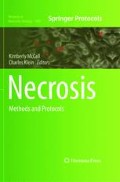Abstract
Perturbances in skin homeostasis are responsible for the development of skin inflammatory diseases such as psoriasis or atopic dermatitis. While the role of apoptosis has been extensively studied in the skin, the role of the newly described programmed necrosis also termed necroptosis in human skin remains poorly understood. We have recently described a mouse model of skin inflammation dependent on necroptotic cell death. Here we describe an immunohistological protocol allowing for the discrimination of apoptotic from necroptotic cell death in a single staining procedure on tissue sections.
Access this chapter
Tax calculation will be finalised at checkout
Purchases are for personal use only
References
Edinger AL, Thompson CB (2004) Death by design: apoptosis, necrosis and autophagy. Curr Opin Cell Biol 16:663–669
Häcker G (2000) The morphology of apoptosis. Cell Tissue Res 301:5–17
Jänicke RU, Sprengart ML, Wati MR, Porter AG (1998) Caspase-3 is required for DNA fragmentation and morphological changes associated with apoptosis. J Biol Chem 273:9357–9360
Golstein P, Kroemer G (2007) Cell death by necrosis: toward a molecular definition. Trends Biochem Sci 32:37–43
Vandenabeele P, Galluzzi L, Vanden Berghe T, Kroemer G (2010) Molecular mechanisms of necroptosis: an ordered cellular explosion. Nat Rev Mol Cell Biol 11:700–714
Feoktistova M, Geserick P, Panayotova-Dimitrova D, Leverkus M (2012) Pick your poison: the Ripoptosome, a cell death platform regulating apoptosis and necroptosis. Cell Cycle 11:460–467
Bonnet MC, Preukschat D, Welz P-S, van Loo G, Ermolaeva MA, Bloch W, Haase I, Pasparakis M (2011) FADD protects epidermal keratinocytes from necroptosis in vivo and prevents skin inflammation. Immunity 35:572–582
Namura S, Zhu J, Fink K, Endres M, Srinivasan A, Tomaselli KJ, Yuan J, Moskowitz MA (1998) Activation an cleavage of caspase-3 in apoptosis induced by experimental cerebral ischemia. J Neurosci 18:3659–3668
Weir EE, Pretlow TG, Pitts A, Williams EE (1974) A more sensitive and specific histochemical peroxidase stain for the localization of cellular antigen by the enzyme-antibody conjugate method. J Histochem Cytochem 22:1135–1140
Streefkerk JG (1972) Inhibition of erythrocyte pseudoperoxidase activity by treatment with hydrogen peroxyde following methanol. J Histochem Cytochem 20:829–831
Wang H, Pevsner J (1999) Detection of endogenous biotin in various tissues: novel functions in the hippocampus and implications for its use in avidin-biotin technology. Cell Tissue Res 296:511–516
Hsu SM, Raine L, Fanger H (1981) Use of avidin-biotin-peroxidase complex (ABC) in immunoperoxidase techniques: a comparison between ABC and unlabeled antibody (PAP) procedures. J Histochem Cytochem 29:577–580
Taylor CR (2006) Standardization in immunohistochemistry: the role of antigen retrieval in molecular morphology. Biotech Histochem 81:3–12
Fischer AH, Jacobson KA, Rose J, Zeller R (2008) Hematoxylin and eosin staining of tissue and cell sections in basics methods in microscopy. In: Spector DL, Goldman RD (eds) Chapter 4: preparation of cells and tissue for fluorescence microscopy. Cold Spring Harbor Laboratory Press, Cold Spring Harbor, NY
Acknowledgment
This work was supported by a grant from the European Skin Research Foundation to M.C.B.
Author information
Authors and Affiliations
Editor information
Editors and Affiliations
Rights and permissions
Copyright information
© 2013 Springer Science+Business Media, LLC
About this protocol
Cite this protocol
Bonnet, M.C. (2013). Immunohistological Tools to Discriminate Apoptotic and Necrotic Cell Death in the Skin. In: McCall, K., Klein, C. (eds) Necrosis. Methods in Molecular Biology, vol 1004. Humana Press, Totowa, NJ. https://doi.org/10.1007/978-1-62703-383-1_10
Download citation
DOI: https://doi.org/10.1007/978-1-62703-383-1_10
Published:
Publisher Name: Humana Press, Totowa, NJ
Print ISBN: 978-1-62703-382-4
Online ISBN: 978-1-62703-383-1
eBook Packages: Springer Protocols

